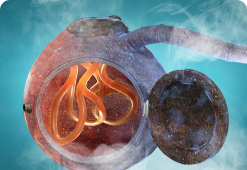IgA nephropathy is a kidney disease that occurs when an abnormal form of the antibody immunoglobulin A (IgA) builds up in the filters (glomeruli) of the kidneys, causing inflammation and damage.1
To learn about what happens inside the kidneys of a person with IgA nephropathy, watch our animation here.
The signs and symptoms of IgA nephropathy are blood in urine (haematuria), foamy urine (caused by protein in urine – also called proteinuria or albuminuria), swelling (oedema), pain, high blood pressure (hypertension), fatigue and brain fog.1,2
Blood in urine isn’t always visible, but when it is, it can make your urine look pink, tea- or cola-coloured.1 It’s caused by blood cells leaking through the damaged glomeruli.1 Protein can leak through the damaged glomeruli too, causing foamy urine.1
IgA nephropathy also disrupts the body’s absorption of fluid, which can lead to swelling, usually in the lower body, hands or face.1 If the swelling is severe, it can be painful.3
Some people with IgA nephropathy experience pain around their kidneys (the sides of the lower back, known as the flank)4,5 and high blood pressure due to the build-up of waste products and excess fluid in the bloodstream.4 IgA nephropathy can also cause fatigue and brain fog.1
Doctors don’t know exactly what causes IgA nephropathy,4 but some scientists think that it’s an autoimmune disease because it is the body’s own immune system that causes harm to the kidneys.1
Doctors can see signs of IgA nephropathy in your urine and your blood.6 For example, high levels of protein (proteinuria) or traces of blood (haematuria) in your urine can be symptoms of IgA nephropathy, as can high levels of creatinine or urea nitrogen in your blood.6 Creatinine is a waste product that’s naturally produced by our muscles,7 and urea nitrogen is a waste product that is naturally produced after the liver breaks down proteins.7 When the kidneys aren’t working well, the levels of creatinine and urea nitrogen in the blood go up, indicating that the kidneys aren’t removing them as efficiently as they should.7
If your doctor finds proteinuria, haematuria, or high levels of creatinine and/or urea nitrogen in your blood, they may recommend renal imaging as a next step.6 This is a non-invasive procedure that uses ultrasound or x-rays to look at the kidneys and check that they are a normal shape and size.6
If abnormalities are found, the final step for formally diagnosing glomerular disease is often to carry out a kidney biopsy.6 A needle is used to take small pieces of tissue from the kidney so doctors can check them under a microscope.6 The biopsy can identify whether it’s IgA nephropathy or another type of glomerular disease.6 For most glomerular diseases, a biopsy is needed to confirm diagnosis.6
Unfortunately, there is no cure for IgA nephropathy, but treatment can help slow down progression and reduce the severity of symptoms.8
Treatment for IgA nephropathy aims to:1
- Slow down the rate at which the disease progresses
- Prevent further damage to the kidneys
- Normalise blood pressure
- Reduce the amount of protein lost in urine
There’s a lot you can do to empower yourself to live as well as possible with IgA nephropathy. From pursuing your passions and staying active to taking care with cigarettes and alcohol, managing your lifestyle can really make a difference to your symptoms and how the condition progresses.8–13
To find out more about managing IgA nephropathy, click here.
Kidneys filter our blood to produce urine, removing toxic waste products and excess water, and keeping in important things like protein and red blood cells.14 This filtering system works using tiny clusters of blood vessels called glomeruli.14 You can think of these as the tiny filters of the kidney.14
Glomerular diseases are a type of kidney disease that specifically affect the glomeruli.6
Types of glomerular disease include:6
- IgA nephropathy
- Focal segmental glomerulosclerosis (FSGS)
- Lupus nephritis
- Membranous nephropathy
- Minimal change disease
- Anti-GBM disease (Goodpasture’s disease)
- Alport syndrome (hereditary nephritis)
Protein in urine (proteinuria or albuminuria) can be a symptom of IgA nephropathy.1 In IgA nephropathy, it means that the filters (glomeruli) in your kidneys have become damaged and are allowing protein (albumin) to leak into your urine.1
The level of protein in urine is useful for diagnosing IgA nephropathy and monitoring how it’s progressing.15 If a person is being treated for IgA nephropathy and the level of protein in their urine either reduces or stays the same, it can mean that their treatment is effective.15
There usually aren’t any visible signs of protein in urine, but if there is a lot of protein in your urine, it can make your urine appear foamy.16
It’s normal to have foamy urine occasionally.17 However, persistently foamy urine can be a sign that protein has leaked into your urine (proteinuria), which is a symptom of IgA nephropathy and other kidney diseases.17
If you notice signs of proteinuria (persistently foamy urine), please speak to your doctor as soon as possible so they can investigate what might be causing it and begin treatment if necessary.18 With proper treatment, the prognosis for people with proteinuria is good.18
Blood in urine (haematuria) can be a symptom of several glomerular diseases.6,19 It means that the filters (glomeruli) in your kidneys have become damaged and are allowing blood cells to leak into your urine.6
However, there are numerous causes of blood in urine, and it’s not always because of a glomerular disease.19 Other causes may include:19
- Infection or inflammation of the bladder, kidney, urethra or prostate
- Kidney stones
- A recent procedure to the urinary tract
- Vigorous exercise
- Sexual activity
- Endometriosis
- Bladder, kidney or prostate cancer
- Disorders that affect how your blood clots, such as haemophilia
- Sickle cell disease
Please speak to your doctor as soon as possible if you notice blood in your urine.
Blood in urine and foamy urine are symptoms of glomerular disease.6 Please speak to your doctor without delay if you notice both or either of these symptoms.

About IgA nephropathy
Watch to learn more about your condition.

Living with IgAN
Learn how you can empower yourself to live as well as possible.

Diet with IgAN
Find out how diet may help maintain kidney function.

IgAN and mental health
However you might be feeling, you’re not alone. Find support here.